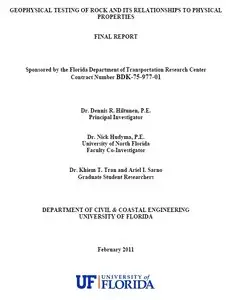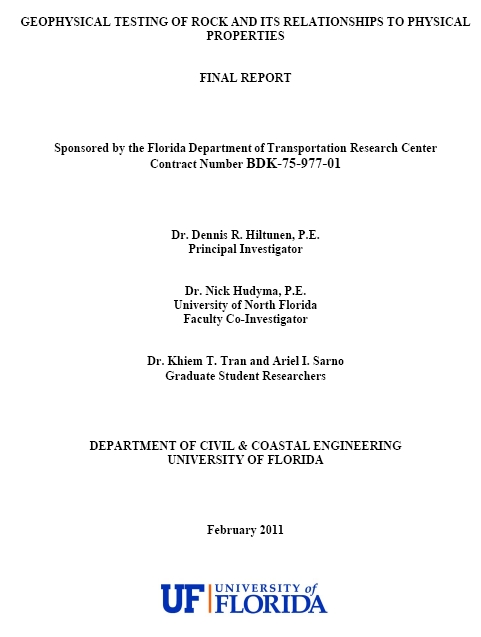"Geophysical Testing of Rock and Its Relationship to Physical Properties" by Khiem T. Tran, Dennis R. Hiltunen, Ariel I. Sarno, and Nick Hudyma
University of Florida | February 2011 | ISBN: n/a | 190 pages | PDF | 4 MB
University of Florida | February 2011 | ISBN: n/a | 190 pages | PDF | 4 MB
Testing techniques were designed to characterize spatial variability in geotechnical engineering physical parameters of rock formations. Standard methods using seismic waves, which are routinely used for shallow subsurface investigation, have limitations in characterizing challenging profiles at depth that include low-velocity layers and embedded cavities. This research focuses on overcoming these limitations by developing two new methods using both sensitive data and a global inversion scheme.
TABLE OF CONTENTS
INTRODUCTION
1.1 Problem Statement
1.2 Objectives
1.3 Scope
1.4 Organization of Report
SITE CHARACTERIZATION METHODS USING SEISMIC WAVES
2.1 Seismic Waves
2.2 Site Characterization Methods Using Seismic Waves
2.2.1 Goals of Seismic Wave Methods
2.2.2 Borehole Methods
2.2.3 Surface Methods
2.3 Overview of the Surface Methods
2.3.1 Methods Using Surface Travel Times
2.3.2 Methods Using Surface Wave Dispersion
2.4 Limitations of the Standard Methods Using Seismic Waves
2.4.1 Limitations due to Insensitivity of Data
2.4.2 Limitations due to Local Inversion Techniques
2.5 Suggested Improvements
2.5.1 Improvements by Using Sensitive Data
2.5.2 Improvements by Employing Global Inversion Techniques
INVERSION OF FIRST-ARRIVAL TIMES USING SIMULATED ANNEALING
3.1 Introduction
3.2 Methodology
3.2.1 Forward Modeling
3.2.2 Optimization Method
3.3 Applications
3.3.1 Applications on Synthetic Data
3.3.2 Applications on Real Test Data
3.4 Chapter Summary
INVERSION OF COMBINED BOREHOLE AND SURFACE TRAVEL TIMES
4.1 Introduction
4.2 Inversion of Synthetic Data
4.2.1 Synthetic Model 1
4.2.2 Synthetic Model 2
4.2.3 Synthetic Model 3
4.3 Inversion of Real Test Data
4.3.1 Newberry Test Site
4.3.2 Ft. McCoy Test Site
4.3.3 Dunedin Test Site
4.4 Chapter Summary
INVERSION OF FULL WAVEFORMS USING SIMULATED ANNEALING
5.1 Introduction
5.2 Methodology
5.2.1 Forward Modeling
5.2.2 Optimization Method
5.3 Applications
5.3.1 Applications on Synthetic Data
5.3.2 Applications on Real Test Data
5.4 Chapter Summary
GEOTECHNICAL ENGINEERING PARAMETER RELATIONSHIPS
6.1 Literature Review
6.1.1 Weathering of Limestone
6.1.2 Classification of Weathering
6.1.3 The Effect of Weathering on Geotechnical Properties
6.2 Laboratory Testing
6.2.1 Limestone Specimens
6.2.2 Specimens
6.2.3 Weathering Classification
6.2.4 Unit Weight Measurements
6.2.5 Dynamic Testing
6.2.6 Static Testing
6.3 Results
6.3.1 Coefficient of Determination Measurements
6.3.2 Introduction to the Developed Relationships
6.3.3 Unit Weight and Weathering
6.3.4 Comparison of Static Elastic Modulus and Unconfined Compressive Strength
6.3.5 Static Properties and Unit Weight
6.3.6 Dynamic and Physical Properties
6.3.7 Dynamic and Static Properties
6.4 Chapter Summary
CLOSURE
7.1 Summary of Findings
7.1.1 Inversion Technique Using Travel Times
7.1.2 Inversion Technique Using Full Waveforms
7.1.3 Rock Parameter Relationships
7.2 Conclusions
7.3 Recommendations
LIST OF REFERENCES
with TOC BookMarkLinks



